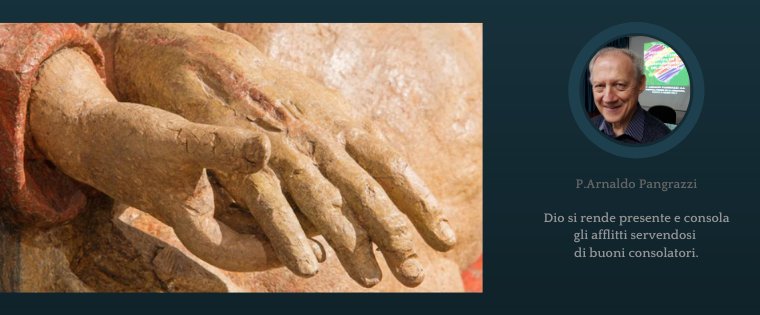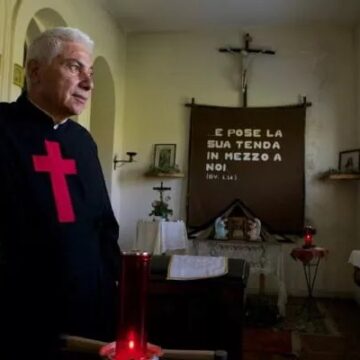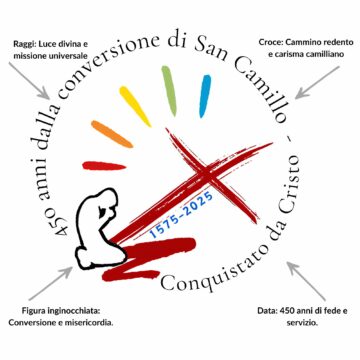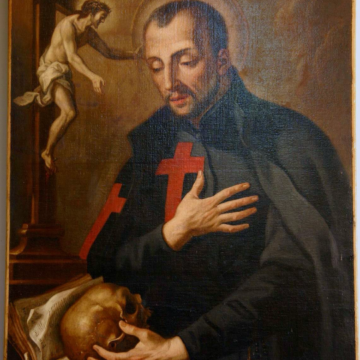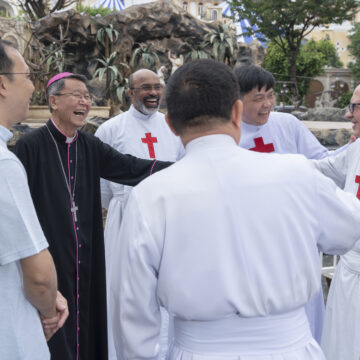Arnaldo Pangrazzi, m.i.
Immersed in mystery
 Life, writes Paul Claudel, “is a great adventure towards the light.”
Life, writes Paul Claudel, “is a great adventure towards the light.”
The Christian faith is founded on Christ, who lived the dramatic event of death and the prodigious event of the Resurrection.
As a testimony of the Paschal event, there is an empty tomb, the apparitions of the risen Jesus, the testimonies of the apostles: “You have killed the author of life, but God raised him from the dead, and we are witnesses” (Acts 2:24).
Christian hope, as the Paschal Preface says, is based on the certainty that “in Him dead has redeemed our death, in Him risen all life resurrects.”
In reflecting on eternal realities, man is conditioned by the experience of the body and mental categories, so it is difficult to understand the difference between the biological body and the body that will be transfigured.
Now we are children of time and space, but one day we will begin a journey without boundaries, from time to eternity.
In the words of Saint Paul: “For we know that if our earthly dwelling, a tent, should be destroyed, we have a building from God, a dwelling not made with hands, eternal in heaven.” (2 Cor 5,1).
Just as it is inconceivable to foreshadow an oak tree contemplating an acorn, just as a child kept in his mother’s womb cannot anticipate his tomorrow, just as all existence is an immense mystery that is discovered as you live it, so one day you will enjoy that bliss that on earth you can only partially anticipate.
The afterlife represents the greatest enigma that has agitated the human mind since the dawn of history, from Persia to Egypt, from Greece to Roman times, from Etruscan civilization to our times.
Since time immemorial, man not only remembers his past roots but also questions his future destiny, what will happen when he dies.
These questions and this research are particularly felt by those who have lost a child and wonder what it is like or what happens in the afterlife.
Faith in the Resurrection does not take away the pain that one inevitably experiences with the death of one’s beloved, but helps to contemplate the event of mortality in the perspective of future immortality, in the confident hope that one day full communion with God and loved ones will be realized.
The centrality of the mystery of the dead and risen Christ informs the Christian that the last word does not belong to the cross, but the life given us by the Risen One: “If Christ had not risen, our faith would have been in vain.” (1 Cor 15,17).
In catechesis on the mystery of death, the Church does not obsessively fixate on the physical dimension, does not favor exaggerated worship of corpses, does not absolutize the value of the  cemetery, but invites believers to reflect on the precariousness of life, the temporariness of earthly goods and to clothe themselves with the new man by practicing works of charity, because the future destiny depends on what they have done with their lives.
cemetery, but invites believers to reflect on the precariousness of life, the temporariness of earthly goods and to clothe themselves with the new man by practicing works of charity, because the future destiny depends on what they have done with their lives.
Many, like Thomas in the Gospel, demand signs, or concrete proofs to believe in heaven. Just as there is no proof before entering this world, so there are no palpable guarantees of what the afterlife will be like. Faith is believing the promise of Jesus: “I am the resurrection and the life, whoever believes in me, even if he is dead, will live.” (Gv 1,25).
Jesus himself, in his teaching, did not describe what heaven will be like; he compared it to a banquet, to a wedding feast.
Even the Church, in speaking of this subject, uses sobriety of language, because eternity escapes the laws of time and space.
The afterlife is not a place but a state of communion with God.
Just as the child lives life as a mystery to be discovered rather than a problem to be solved, so the Christian is called to entrust himself to that God who has promised: “Do not be afraid, behold, I am with you every day, until the end of the world” (Mt 28:20).
One prepares for the afterlife by practicing the gospel on the other side of the world.
The plurality of grief: problems and resources
 Faith helps to endure detachment from a loved one given a future destiny, but the pain of detachment remains.
Faith helps to endure detachment from a loved one given a future destiny, but the pain of detachment remains.
Grief has many faces and implications. The mourner can be the father or mother, spouse, boyfriend, close friend, brother or sister, son or daughter, nephew, brother, or sister. Each loss has different implications, depending on the intensity of the bond and the role of the deceased in the lives of the survivors.
Good Friday or the trip to solitude for those who stay does not last three days, months, and sometimes years. A particular role in the elaboration of grief is characterized by the causes of death, which can be a miscarriage or procured abortion, a chronic or terminal illness, or wholly unexpected and lacerating facts, such as a stroke, a heart attack, a car accident or at work, suicide or murder. Each tragic circumstance involves different reactions and moods influenced in turn by the cultural context, the available external support, and the resources of the protagonists, in particular, the attitudes assumed in the face of loss.
Grief in itself is not a disease, but a “risk factor” for health.
The costs of mourning burden the health budget through the onset of diseases (hypertension, cancer, depression, mental illnesses …), loss of productivity at work (absences, alcohol or drug addiction …), existential problems (deterioration of lifestyle, loneliness, isolation …).
Society and the Church are called to intervene and collaborate, through health professionals, social services, and listening centers, to contain the costs of mourning and promote the health of the wounded.
In particular, the Church, religious communities, volunteers, neighbors are called to practice the fourth work of mercy “to console the afflicted,” avoiding those stereotypes of consolation that  mortify the sense of Christian proximity.
mortify the sense of Christian proximity.
The art of knowing how to accompany those in mourning requires humility, discretion, and emotional competence.
The first form of comfort is presence, not words.
You make yourself close through a visit, a phone call, the offer to accompany those in mourning to the cemetery, to a prayer group, to the supermarket, or for a walk.
In mournful experiences, especially dramatic ones, the healing process slowly makes its way, so you approach them gently, allowing the crying and the outbursts of bitterness, giving space to questions and bewilderment, welcoming regret, and silence.
The drug that relieves the affliction is listening to what the other person feels, thinks, experiences.
The term that interprets the ability to be in tune with the sufferer is called “empathy,” which designates the ability to accept the moods and thoughts of the other without contrasting them, relativizing them, or trivializing them.
The current historical period, marked by Covid-19, has shown how fragile our security is and how essential it is to consolidate forms and gestures of solidarity to cross the long tunnel of the pandemic together.
The Church, following the example of her teacher, has always been at the forefront in helping the weak, dressing the naked, feeding the hungry, consoling the afflicted.
Beyond the contagion and its victims, every community, family, and person – over time – are faced with a burden of loss and detachment.
The community or parish becomes healing insofar as, within it, the number of people motivated and prepared to pour the balm of consolation on the wounds of those who have experienced painful detachments is consolidated.
Lao Tse, a philosopher of the sixth century BC and founder of Taoism, suggested that: “Whoever wants to bring light, must know the darkness that is about to lighten.”
Frequently, those who wish to bring the light of comfort let themselves be conditioned by haste, the need to challenge the emotions and thoughts of those in mourning, the urgency to dictate their schedule or agenda to those who suffer.
Don’t be “troublesome comforters” (Job 16,2)
 Goodwill is not enough to help. One cultivates an educated heart by learning in primis to unlearn those ways of being based on the conviction that the goal of cheering up those who are sad can only contribute to their good. W. Shakespeare pointed out that: “Everyone knows how to give advice and comfort to pain that they do not feel.”
Goodwill is not enough to help. One cultivates an educated heart by learning in primis to unlearn those ways of being based on the conviction that the goal of cheering up those who are sad can only contribute to their good. W. Shakespeare pointed out that: “Everyone knows how to give advice and comfort to pain that they do not feel.”
The practice of true mercy advises stemming the consolatory anxiety of these well-meaning people, dressed in preaching tendencies or carrying easy, reassuring formulas, as a prelude to entering wisely into mournful landscapes.
To immerse ourselves in the concreteness of daily encounters, the following are a range of stereotypes or four types of recurring behaviors to watch over because they could hurt instead of comforting those in mourning.
- Expressions aimed at dampening feelings, such as: “Don’t cry,”; “Don’t feel this way,”; “Don’t get angry,”; “Crying about the past is useless”; “Try to stay calm.” The risk is to stifle or judge feelings, instead of welcoming and understanding them.
In practice, the helper acts like a firefighter who throws water on the fire, often because silence disturbs him or is uncomfortable in managing his emotions and requires, in some way, that the aggrieved do the same by repressing them or ignoring them.
- Expressions that leverage values, such as: “You must be strong for your children”; “He who believes in God, does not cry”; “Think of those who suffer more than you”; “Be calm, time heals everything”; “Think of something else, not your pain”; “You just have to look ahead.”
Certainly, values such as faith, family responsibilities, courage, and so on play an important role in the recovery from grief, but not by evading or bypassing feelings or accelerating the healing processes of those torn and upset.
- Expressions aimed at transmitting hope, such as saying to a mother who lost a creature during pregnancy: “It was better this way, now she is no longer suffering” or “She will soon have other children”; or to a young widow: “You are beautiful, you will marry again“; or to a couple of parents who lost a child: “You are lucky that you have an angel in heaven to protect you,” or “You must thank for the daughter that remains to you.”
The consoler intends to redeem the positive elements of the situation, instead of watching over the grieving on Good Friday; in practice, he tries to sweeten the bitter morsel by administering hope, often inappropriate or premature, to mitigate the discomfort.
- Religious expressions to transform or sublimate pain, such as: “God knows what is best for us,”; “It was God’s will,”; “God needed him”; “God takes the most beautiful flowers for his garden”; “No leaf falls unless God wants.”
These phrases, sometimes uttered from the pulpit or by religiously angry consolers, could turn out to be bad publicity for God perceived as the one who sent leukemia to a child or decided the death of a young man in an accident or as the God who ignores the pleas of a family invoking the healing of a loved one. The risk is to present God as cruel and intent on disturbing the peace and joy of his children.
It may happen that the recipients of these messages, upset by such expressions, decide to abandon the Church, bittered by these sudden proposals of divine intervention.
The therapy of understanding
“If you want to be closer to God, Gibran said, stay closer to people.”
It soothes the pain by allowing those in mourning to speak of their love, knowing that Jesus also mourned the death of his friend Lazarus. Tears are not a sign of weakness, but love.
The verbalization of impulses of anger and protest does not mean that those in mourning have cut the relationship with God, but that these moods arise from the impact with the sense of helplessness and frustration for a changed life.
The remorse and regret transmitted by the survivors for mistakes made, unfinished things, or lost opportunities are spontaneous confessions to be welcomed, without hurrying to curb or suffocate them.
The invitation to those who wish to be close to those in pain is to remember that the path to transforming “misfortune into grace” is long and tortuous.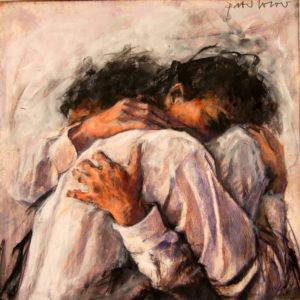
God makes Himself present and consoles the afflicted by using good consolers.
The consoler is, first of all, a person who has experienced the consolation of feeling loved and healed by God: “Blessed be the God and Father of our Lord Jesus Christ, the Father of compassion and God of all encouragement who encourages us in our every affliction, so that we may be able to encourage those who are in any affliction with the encouragement with which we are encouraged by God.“ (2 Cor 1,3-6).
Pain is soothed through beneficial presence, attentive listening, words that arise from the heart, and a mosaic of small gestures that testify proximity and hope.
In the words of St. Teresa of Calcutta: “He who in the path of life has lit even a torch in someone’s dark hour has not lived in vain.” Pain – for those who help and those who are helped – is a demanding school, but precious to renew and increase one’s ability to love.



